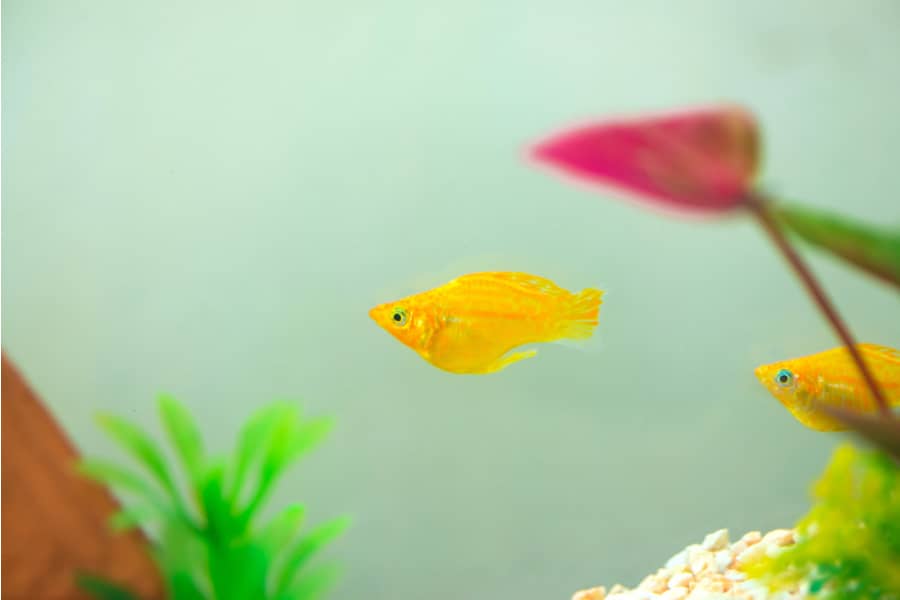How To Tell If A Molly Fish Is Dying And What To Do?
Molly fish are a popular type of freshwater fish that most people prefer in their aquariums. They are typically very hardy fish, but like any other living creature, they can get sick and die.
There are some signs to look for that may indicate your molly fish is dying. Wondering what they are? If so, keep reading this article.
In this article, we’ll cover the signs that can tell you if your mollies are dying, or if they are sick, etc.
So without further ado, let’s get into it!
8 Signs To Tell If A Molly Fish Is Dying

In order to tell if a molly fish is dying, you can look for some obvious signs. A dying molly fish shows signs such as lack of appetite, popeye, swollen gills, lethargic behavior, a change in coloration, clamped fins, white specks on its skin, fins falling off, strange behavior such as sitting at the bottom, etc.
If you notice any of these signs and others mentioned below, then chances are that your molly is dying.
Below are the 8 signs to know if a Molly Fish is dying:
1. Lack Of Appetite
Loss of appetite is one of the most common signs that a molly fish is dying. If you notice that your molly fish is not eating as much as it used to or not eating at all, it is a sign that the fish is either dying or sick.
Usually, a dying fish do not swim to the surface despite being offered its favorite food.
A loss of appetite in molly fish can be caused by several things, including stress, illness, or even old age.
Moreover, if your mollies stop eating, poor water quality could also cause the problem.
So if the molly fish is not eating, it is likely that it is just old and is nearing the end of its life.
2. Lethargy
Lethargy is yet another common sign that a molly fish is dying.
When molly fish is on the verge of dying, it will become less active, and the fish won’t have the energy or the motivation to swim around as much as a healthy fish.
Your molly fish may be dying or ill if you observe that it is swimming less or is simply resting at the bottom of the tank with little to no movement.
Moreover, if the molly fish has trouble staying upright, has lost interest in socializing, hides more often, and seems lazy, this behavior implies that the molly is dying.
3. Clamped Fins
If the fins of your molly fish are clamped together or are held close to its body and are not flowing freely, it could mean that your fish is in serious trouble.
The fins of a healthy molly fish should be spread out and relaxed. If you see that the fins of your molly fish clamped together, it could be a sign of stress or illness.
4. Change in Coloration
A molly fish’s color will typically get duller when it is about to die.
Typically, molly fish are orange and light brown in color with black markings on their sides. However, they also come in bright colors like red and blue.
If you notice that the colors of your molly fish have faded, it means that the time for the fish has come to an end.
Generally, a dying molly fish will start to lose its color and become pale or even grey.
5. Pop-Eye
Popeye is a bacterial infection and is a condition in which a molly fish’s eye bulges out from its socket and has fluid discharge from the eye or bubbles over the eyes.
All these symptoms mean that you must take proper care of the fish and consult a vet for any medication or remedies.
6. Swollen Gills
Swollen gills can result from a Parasitic Infection known as “Flagellates .”Swollen and enlarged gills indicate that the molly fish is not getting enough oxygen or having difficulty breathing.
If left untreated and the condition persists, the molly will eventually die.
Hence, if you notice the above symptom, you must immediately get in touch with a vet.
7. Fins Falling Off
Fins falling off is yet another sign that your molly fish is dying. If you notice that the fins of your molly fish are falling off, it may be due to environmental changes or without any reason.
Upon noticing it, you should contact a vet immediately to get the right treatment.
8. White Specks on the Skin
If you notice white specks or spots on your molly fish’s skin, which is a very common parasitic infection and often caused due to uncleaned water. You need to quarantine your molly fish as the disease can be passed from one to another.
Furthermore, if it is not treated in time, it can lead to the death of your molly fish.
Why Do My Molly Fish Keep Dying?
There are many reasons your molly fish keeps dying; some of the most common ones are bad water quality, overfeeding, uncycled aquariums, diseases & parasites, shocks due to travel fatigue, etc.
How do you save a molly fish from dying?

Follow these four tips to save molly fish from dying –
1. Do not overfeed your mollies
Overfeeding will make the fish produce a lot of waste, making the tank dirty too quickly, and ultimately dropping oxygen levels. The molly fish can die due to a lack of oxygen in the water.
2. Always Keep The Tank Clean
You should clean the tank regularly to avoid the accumulation of waste in the tank, which can cause poor water quality. You should check the water parameters regularly and ensure that the water is not too warm or too cold. Also, make sure to maintain the pH level of the water.
Moreover, regular water changes are essential for maintaining a healthy tank. It helps remove pollutants and toxins from the tank and replenish oxygen levels.
3. Check for Ammonia, nitrites, and nitrates
Checking Ammonia, nitrites, and nitrates levels in the water is essential in maintaining a healthy tank. If the levels of these chemicals are too high, it can cause serious harm to the molly fish.
4. Check for any signs of illness
If you notice any signs of illness (such as white spots, cloudy eyes, etc.) in the molly fish, it is essential to take the necessary steps to treat the illness and consult a vet if needed.
Conclusion
So, that’s it for today’s blog. We hope after reading this article, you know how to tell if a molly fish is dying.
It can be heartbreaking to see your beloved molly fish die. But with the right knowledge, you can be prepared to spot any signs of illness and act accordingly.
In a nutshell, to tell if a molly fish is dying, you must be vigilant and look out for signs such as lack of appetite, popeye, swollen gills, lethargic behavior, etc.
If you notice any of these signs and others mentioned above, then chances are that your molly is dying. At this point, you should immediately seek help from a veterinarian or an experienced aquarium keeper.
